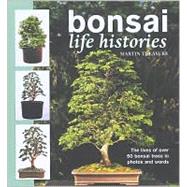
Martin Treasure has been interested in bonsai since his teens, when he joined several bonsai societies and began attending exhibitions, specialists nurseries and gatherings of bonsai devotees. He was encouraged by many of the eminent names in the bonsai world, who recognized his talent, vision and individuality. Soon, his trees were to be seen at national and international exhibitions and at the Chelsea Flower Show, where in 1995 and 1996 he had a total of 12 trees on the Federation of British Bonsai Societies stand, which won a Silver Gilt Medal. He began giving lectures, all the while building a unique photographic record of the development of the trees in his collection, spanning over 15 years.
| introduction | 6 | (2) | |||
|
8 | (16) | |||
|
8 | (8) | |||
|
16 | (1) | |||
|
17 | (1) | |||
|
18 | (6) | |||
|
24 | (22) | |||
|
24 | (1) | |||
|
25 | (1) | |||
|
26 | (1) | |||
|
27 | (2) | |||
|
29 | (2) | |||
|
31 | (3) | |||
|
34 | (2) | |||
|
36 | (2) | |||
|
38 | (4) | |||
|
42 | (2) | |||
|
44 | (2) | |||
|
46 | (84) | |||
|
46 | (4) | |||
|
50 | (2) | |||
|
52 | (4) | |||
|
56 | (2) | |||
|
58 | (6) | |||
|
64 | (2) | |||
|
66 | (4) | |||
|
70 | (2) | |||
|
72 | (4) | |||
|
76 | (2) | |||
|
78 | (4) | |||
|
82 | (2) | |||
|
84 | (2) | |||
|
86 | (2) | |||
|
88 | (2) | |||
|
90 | (2) | |||
|
92 | (4) | |||
|
96 | (2) | |||
|
98 | (2) | |||
|
100 | (4) | |||
|
104 | (2) | |||
|
106 | (2) | |||
|
108 | (2) | |||
|
110 | (2) | |||
|
112 | (2) | |||
|
114 | (2) | |||
|
116 | (2) | |||
|
118 | (2) | |||
|
120 | (2) | |||
|
122 | (2) | |||
|
124 | (4) | |||
|
128 | (2) | |||
|
130 | (12) | |||
|
130 | (2) | |||
|
132 | (2) | |||
|
134 | (2) | |||
|
136 | (6) | |||
| addresses and glossary | 142 | (2) | |||
| index | 144 |
The New copy of this book will include any supplemental materials advertised. Please check the title of the book to determine if it should include any access cards, study guides, lab manuals, CDs, etc.
The Used, Rental and eBook copies of this book are not guaranteed to include any supplemental materials. Typically, only the book itself is included. This is true even if the title states it includes any access cards, study guides, lab manuals, CDs, etc.